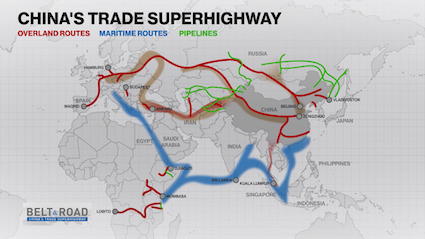China’s Massive Belt and Road Initiative

China’s Belt and Road Initiative is the most ambitious infrastructure investment effort in history. But is it also a plan to remake the global balance of power?
Andrew Chatzky and James McBride, CFR
In 2013, Chinese President Xi Jinping announced the launch of both the Silk Road Economic Belt and the 21st Century Maritime Silk Road, infrastructure development and investment initiatives that would stretch from East Asia to Europe. The project, eventually termed the Belt and Road Initiative (BRI) but sometimes known as the New Silk Road, is one of the most ambitious infrastructure projects ever conceived. It harkens back to the original Silk Road, which connected Europe to Asia centuries ago, enriching traders from the Atlantic to the Pacific.
Some analysts see the project as an unsettling extension of China’s rising power, and as the costs of many of the proposed projects have skyrocketed, opposition has grown in some participant countries. Meanwhile, the United States shares the concern of some in Asia that the BRI could be a Trojan horse for China-led regional development, military expansion, and Beijing-controlled institutions. Under President Donald J. Trump, Washington has raised alarm over Beijing’s actions even as it has abandoned some U.S. efforts to isolate China and deepen its own ties with economic partners in the region.
What was the original Silk Road?
The Silk Road came into being during the westward expansion of China’s Han Dynasty (206 BCE–220 CE), which forged trade networks throughout what are today the Central Asian countries of Afghanistan, Kazakhstan, Kyrgyzstan, Tajikistan, Turkmenistan, and Uzbekistan, as well as modern-day India and Pakistan to the south. Those routes extended more than four thousand miles to Europe.
Central Asia was thus the epicenter of one of the first waves of globalization, connecting eastern and western markets, spurring immense wealth, and intermixing cultural and religious traditions. Valuable Chinese silk, spices, jade, and other goods moved west while China received gold and other precious metals, ivory, and glass products. Use of the route peaked during the first millennium, under the leadership of first the Roman and then Byzantine Empires, and the Tang Dynasty (618–907 CE) in China.
But the Crusades, as well as advances by the Mongols in Central Asia, dampened trade, and today Central Asian countries are economically isolated from each other, with intra-regional trade making up just 6.2 percent of all cross-border commerce. They are also heavily dependent on Russia, particularly for remittances—they make up one-third of the gross domestic product (GDP) of Kyrgyzstan and Tajikistan. By 2018, remittances had dipped from their 2013 highs due to Russia’s economic woes.
What are China’s plans for its New Silk Road?
President Xi announced the initiative during official visits to Kazakhstan and Indonesia in 2013. The plan was two-pronged: the overland Silk Road Economic Belt and the Maritime Silk Road. The two were collectively referred to first as the One Belt, One Road initiative but eventually became the Belt and Road Initiative.
Xi’s vision included creating a vast network of railways, energy pipelines, highways, and streamlined border crossings, both westward—through the mountainous former Soviet republics—and southward, to Pakistan, India, and the rest of Southeast Asia. Such a network would expand the international use of Chinese currency, the renminbi, while new infrastructure could “break the bottleneck in Asian connectivity,” according to Xi. (The Asian Development Bank estimates that the region faces a yearly infrastructure financing shortfall of nearly $800 billion.) In addition to physical infrastructure, China plans to build fifty special economic zones, modeled after the Shenzhen Special Economic Zone, which China launched in 1980 during its economic reforms under leader Deng Xiaoping.
Xi subsequently announced plans for the 21st Century Maritime Silk Road at the 2013 summit of the Association of Southeast Asian Nations (ASEAN) in Indonesia. To accommodate expanding maritime trade traffic, China would invest in port development along the Indian Ocean, from Southeast Asia all the way to East Africa.

